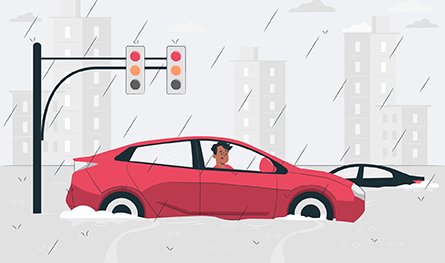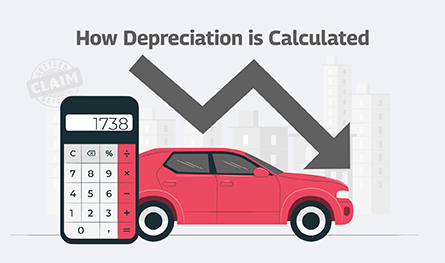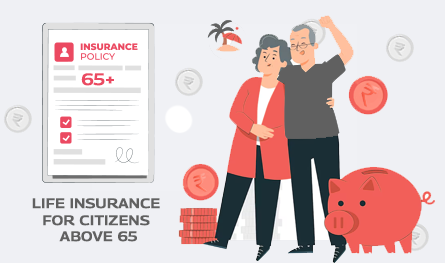8 Tips to Drive Car Safely Through Waterlogged Roads


How to Drive in Waterlogged Roads Safely?
Waterlogging is one of the ordeal experiences that most car owners often face during the monsoon season. The pits and cavities and water logging on roads that are dangerous threats for vehicle owners and pedestrians which lead to various fatal accidents. But due to inferior drainage systems, driving in water logged area is a quotidian phenomenon in big cities. So, every car owner should keep in mind how to drive a car before hitting Indian roads during the rainy season. In this article, we are going to elaborate on how to drive car safely through waterlogged roads.
8 Tips on How to drive a Car in Waterlogged Areas
1. Check the water level before entering a road
This is one of the prime safety tips while driving car in water or submerged roads. Always check the water level of the road before driving on the road. If the tyres of the car get submerged, then driving could become perilous. As a result, you can face various problems including engine failure, accidents, oil leakage and so on. To avoid this situation, you should look for an alternate route. Though this could be time-taken and long, never compromise your safety.
2. Stay in the central part of the road
Most Indian roads are constructed in such a way that the rainwater gets accumulated on the side of the road in case of heavy rainfalls. During the monsoon, when the drains are clogged, the water gets stuck on the sides of the road. As a result, the water level could be minimal in the middle of the road. Moreover, when a heavy vehicle crosses the road, the water gets exiled to the side of the road. This could increase the side water level and you may find difficulties in running your car. So, always drive your car towards the center of the road. This tip may give you an idea if you are thinking about how to drive a car in rain.
3. Don’t lose your calm while driving through flood water
It could be an arduous job to drive in submerged lanes as you need to go slow and use lower gears. While moving, you would need to switch between first gear and second gear without upsetting the throttle. You must maintain a steady RPM level so that rainwater can’t block the exhaust pipe of the car.
4. If stuck in water, never restart your engine
If you can’t move your car in submerged lanes, never start the engine immediately. There could be several reasons to avoid this. While starting your engine on water-logged roads, water may put additional pressure on the connecting rods of the engine. As a result, they get shattered. Moreover, if water reaches the engine through the intake or exhaust, the engine may get burnt. To repair this damage, you need to pay a hefty amount from your pocket. If you think water has invaded the engine, switch off the car to avoid more damage. Take your car to an area which is not submerged and get in touch with emergency services.
5. Stay away from the hydrostatic lock
When you try to start the engine forcefully (if it is submerged in rainwater), it might become a victim of a hydrostatic lock which can create more damage. If this happens, you need to take your car to the nearby service center.
6. Never panic
While driving your car on inundated streets, when you get trapped in a sodden area, don’t lose your patience. Rather drive calmly. Don’t try to get down from the car or get involved with arguments as they will create more problems for you. Always keep focus and drive peacefully instead of panicking.
7. Don’t drive hastily
Though many people (especially youngsters) prefer to drive speedily on waterlogged roads, this could damage your vehicle more. Indian roads are flooded with pits and potholes. If you drive hurriedly, you may end up hitting those potholes. As you can’t control the speed of the vehicle, this could also be dangerous for you and others on the road. So, drive your car slowly during the rainy season.
8. Choose an alternative route
During the rainy season to avoid monsoon-related worries, always prefer roads that are less flooded. Maybe these streets are overcrowded, but you can save a lot of money that you may need to spend to repair your car. Select the route in advance before leaving your house/office and keep checking on the weather forecast. Sometimes, you can’t schedule your travel plans based only on the weather forecast, so you should prudently decide whether you will use public transport or take your own car.
These are some car safety tips that you should ponder while taking out your car in the monsoon season. Most importantly, buy car insurance online to enhance the safety of yourself as well as your car. Nowadays, many general insurance companies are welcoming their customers with car insurance online where a policyholder can not only purchase insurance but also conveniently renew insurance online.
To enjoy uninterrupted services and coverage, the car insurance renewal online process is a necessity for all. Check various portals and find the best motor vehicle insurance online in India to make your car monsoon-ready.
Driving the car during the monsoon season could be a daunting task for both the owner and the vehicle. Whenever you need to take out your car during the rainy season, drive it slowly so that you don’t lose control. To cope with all monsoon-related huddles, prepare your car for pre-monsoon check services to drive peacefully during the monsoon.

Author Bio
Paybima Team
Paybima is an Indian insurance aggregator on a mission to make insurance simple for people. Paybima is the Digital arm of the already established and trusted Mahindra Insurance Brokers Ltd., a reputed name in the insurance broking industry with 17 years of experience. Paybima promises you the easy-to-access online platform to buy insurance policies, and also extend their unrelented assistance with all your policy related queries and services.
Other Motor Insurance Products
Latest Post
So, you’ve crossed the fabulous 60 mark. Retirement may be on the cards, your kids might be off doing their own thing, and suddenly your knees are making more noise than your WhatsApp notifications. Welcome to the senior citizen club.
Now let’s talk about something most of us tend to postpone until a doctor gives us a reality check: health insurance. If you are wondering whether buying health insurance after 60 makes sense, the answer is a loud and clear yes. This article will cover everything you need to know about it, how it makes sense, how it differs from health insurance for young adults, and what you need to look out for when checking for medical insurance above the age of 60.

.png)
April 2 is observed as World Autism Awareness Day and there is no better way to observe the day than to raise awareness of this condition and to promote kindness towards autistic people. Read on to know more.


Car depreciation implies the difference between the cost of a car at the time of buying the car and when you sell it. A car insurance claim amount is determined by the car depreciation rate. The car depreciation rate is the reduction in the value of your car over its lifespan caused by wear and tear.


Fixed Deposits (FDs) are one of the safest ways to grow your savings. HDFC Bank offers attractive FD interest rates, allowing you to earn guaranteed returns on your investment. But before you invest, it's important to know how much interest you will earn and what your final maturity amount will be.


If you think of life insurance, chances are you are picturing something people buy in their 30s or 40s. But what if you are 65 or older and just getting started? The good news is that you are never too late. Whether you are thinking of easing the financial burden on your family, covering final expenses, or simply leaving behind a legacy, there are life insurance options tailored just for you.
This article will be a guide to life insurance for senior citizens above 65 years, explaining why it is important, the type of insurance options, and how to get the right policy for you.






 Car Insurance
Car Insurance
